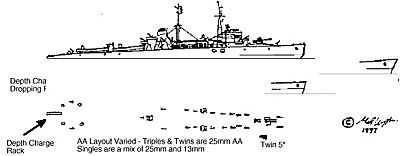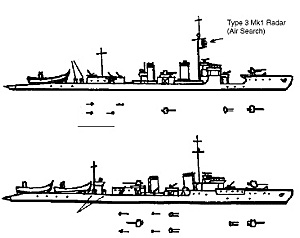
During the so called "China Incident," which preceded WW II in the Pacific, the Imperial Japanese Navy realized the need for fast vessels capable of delivering a small number of troops to enemy-held territory as well as having the firepower to protect themselves and a landing force. In 1939, therefore, several overage destroyers were re-rated as "Patrol Boat" (Ishokai-Tei) and refitted for a new role. This designation was apparently based on the expectation the ships would only be needed for landings during the initial phase of a Pacific War or for limited operations off the coast of China. It was expected that for normal duty they would fulfill the role of escort vessels, but without torpedo armament. A lack of torpedoes meant they were no longer destroyers either, hence "Patrol Boat" was selected.
In 1939, Patrol Boat No.1 was converted from the destroyer Shimakaze of the Minekaze class along with her sister ship Nadakaze as PB No.2. Both had been built by Maizuru. The conversion entailed the removal of all torpedo tubes and reducing the 4.7" guns from four to two. Four twin 25mm AA guns were added along with 18 depth charges and four racks. When not carrying troops and landing craft this could be increased to 60 depth charges to give the vessels a very useful escort capacity.
The well deck forward of the bridge was filled in to provide extra accommodation. Two boilers were removed which also increased the fuel and storage capacity. Even with reduced power the ships could still make 20 knots. One of the most obvious alterations was to the stern and after deck areas. These were sloped down to the waterline to enable the ships to carry two 46ft Daihatsu landing craft which could be slid backwards into the sea while underway at slow speed. The landing craft were arranged one behind the other and could be loaded with stores before launch.
As rebuilt, they could carry 250 troops for a reasonable distance but somewhat less for a long voyage. The troops were only equipped with their own personal weapons and some additional stores. The new arrangements required extra ballast to be fitted with a consequent rise in displacement from the original 1,270 tons standard to about 1,700 tons. They were also given the ability to adjust their ballast to compensate for carrying heavy stores aft.
Both these ships were in action from the outbreak of the Pacific War. The capabilities made them important units during the invasion of South East Asia, during which they took part in several landing operations. By 1943, when Japanese expansion had stopped, they were still in the south. Both had an extra four single 25mms added but it was a submarine, not aircraft, that sank PB No.1. She fell victim to USS Guardfish 65 nm WSW of Kavieng, New Ireland while making a supply run out of Rabaul. PB No.2 had her AA increased again in 1944 for a total of 16 25mm. My drawing shows her only with ten because it is unclear where the extra guns were placed. It is possible there were one or two triple mounts forward of the bridge and the amidships mounts also became triples.
Fate caught up with her on the 25th of July 1945, when she was torpedoed by a British submarine 175 nm East of Soerabaja, Java.
Although the previous two destroyers had proved to be of ideal size, the IJN had few such ships to spare for conversion. Consequently they turned to the smaller Momi-class vessels. Those selected were Aoi (PB32), Hagi (PB33), Sutsuki (PB34), Tsuta (PB35), Fuji (PB36), Yomogi (PB38), and Tade (PB39), Kiku (PB31) and the similar Wakatake-class ship Yugao (PB46) were also selected, but they were not given the same conversion. They were only ever used as escorts and had no landing craft facilities. They carried 2 x 4.7", three twin and two single 25mm AA plus fifty depth charges and four racks.
The larger group were, however, altered to carry 150 troops for the APD role. As converted, they were armed with two 4.7" guns, but due to size limitations had only two twin 25mm, which were sited amidships. All retained the aft boiler for stability, although it was deactivated and much of the space used for storage. In this form they could make 18 knots. PBs 33, 34, 35, 36, and 37 all had their forefunnels raised and capped prior to conversion and it is believed these units had the aft funnel removed.
The others retained two funnels. The stern was modified as in the larger boats but although more sloped, only a single Daihatsu could be shipped. Four depth charge racks were fitted along with 18 depth charges but this could be increased to 60 if no troops were aboard.
By 1944, these ships had their AA increased by the addition of four single 25mm. A twin 25mm mount was placed in front of the bridge. PB36 survived long enough to be fitted with the "hanging lantern" Type 3 Mk2 radar on her foremast. PB32 & PB33 were early losses, being run deliberately aground during the Wake Island invasion of the 23rd of December 1941. The seas were too high for them to launch their Daihatsus but grounding enabled them to complete their mission. Some sources say they were hit and damaged by US shore batteries first, but that is only to have been expected if they were coming in that close.

No.35 was sunk by aircraft at Lae in New Guinea during 1943. PB37 was hit by three torpedoes and gunfire from US destroyers during the landings there. The wreck was raised by the IJN but was beyond repair. PB38 & PB39 were sunk by submarines, the last in 1945. PB36 was captured at Soerabaja after the war where she had been undergoing repairs and was handed to the Dutch Navy. PB34 was at Truk repairing major collision damage when she was sunk by air attack in 1944. Japanese sources show this ship carrying Type 3 Mk1 radar but this seems unlikely due to her extensive southern service and being sunk while still there. Perhaps the fitting was carried out by a repair ship, which could explain it.
For a bunch of very old destroyers, which would have been of doubtful combat use with the fleet, these conversions proved valuable. All were hard used and the nature of their losses in frontline areas indicates they were heavily in demand, trying to resupply isolated Japanese garrisons once the war turned against them.
Although I have mentioned their ability to be used as escorts, it would seem this was a feature not often used. Their role as fast transports kept them all busy until lost.
The value of the Patrol Boat conversions was seen early, but the demands of the war prevented the next group undergoing such extensive conversion, or losing all their capacity to operate as fleet units. These were the Mutsuki class, all of which retained their names. Although the main armament was reduced to two guns, torpedoes were retained and no boilers were deactivated. None of these units survived the war and most were sunk during the vicious battles for the Solomon Islands.
Because of the success of the conversions the IJN embarked on a class of purpose-built ships (Itto Yuso Kan) of the No.1 type which were 22-knot ships that could carry four large and one small Daihatsu on a sloping deck. They could carry small tanks or even Kaiten. Although a specifically-built type they are almost exact equivalents to the US Navy conversions from destroyer escorts into APDs late in the war.
The No.1 type were used to transport supplies and midget submarines to various bases during the latter part of the war. They were well-armed with a twin 5" mount and 15 to 26 light AA of 25mm or 13mm. They had a larger radius of action and could carry a very respectable 42 depth charges along with 4 racks and one rail. Type 2 Mk2 radar was also fitted.
Nos 1 to 22 were completed, but Nos 23 to 46 were cancelled due to lack of materials and other priorities. Sixteen of the class were lost from 1944 to 1945 and the rest scrapped or handed over to the Allies as reparations. The fitting of a sloping deck was not limited to the ships so far described. The cruisers Kitakami and Oi were similarly altered but are more famous as carriers of Kaiten suicide submarines or bearers of a huge torpedo battery.
The Destroyer Escort D type, (Kuchiku-Kan, Tei-Gata) Take of the Matsu class was also fitted with a sloping stern to carry Kaiten, but as this was a standard fitting she could also have carried Daihatsus. The ex-Minekaze destroyers (Kuchiku-Kan) Namikaze (Strong Wind) & Shiokaze (Sea Wind) were converted in 1945. They lost all their torpedoes and carried a single 4.7" gun forward and about 14 25mm, plus the typical hanging lantern type radar. The first boiler was removed and the forefunnel thinned.
In Shiokaze, the empty boiler space had seven stripped Kaiten hulls put in it and these were fitted as fuel tanks, raising her bunkerage by 50 tons. Speed was reduced to 25 -28 knots. The stern was cut down and raked aft, enabling the first ship to carry two Kaiten and the latter four. In each case Daihatsu craft could have been carried if needed. These ships were not renamed or redesignated as Patrol Boats. Both survived the war, Shiokaze being scrapped and Namikaze handed over to China.
Japan's old destroyers converted to the fast transport role saw useful service which greatly increased their value and extended their capabilities. Their war service was as tough, demanding, and dangerous as that of any other units of the fleet.
BT
Back to The Naval Sitrep #12 Table of Contents
Back to Naval Sitrep List of Issues
Back to MagWeb Master Magazine List
© Copyright 1997 by Larry Bond and Clash of Arms.
This article appears in MagWeb (Magazine Web) on the Internet World Wide Web.
Other military history articles and gaming articles are available at http://www.magweb.com